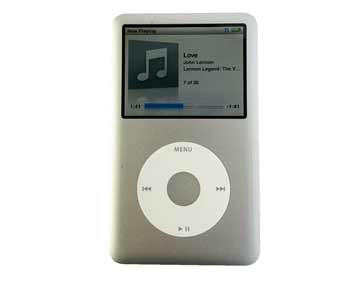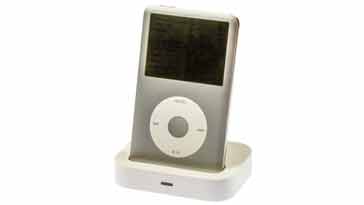The iPod Story: history of the iPod
Discover the story of the Apple iPod from its inception, through the products to the time when the last iPods were sold.
Audio Technology History Includes:
Sony Walkman
Apple iPod
Throughout the history of technology, there are a few items that stand out as being not only technologically innovative, but also iconic and stylish. One product that has to fit into this category must be the Apple iPod.
Although now discontinued by Apple, the iPod remains in the hearts and minds of everyone as one of the "must-have" items of technology.

Other players were available, but they tended to be large, clunky and not particularly nice to use.
The iPod was sleek, stylish and a dream to use by comparison, although this had not come easily.
The iPod story starts
Cast your mind back to the year 2001 - remember Napster? It was blazing a trail with streamed music over the Internet. CD players were still the main route for music sales, although very few cassettes and vinyl discs were sold.
the story of the iPod does not start with Steve Jobs as might be expected. Instead the idea came from Tony Fadell, a former Philips engineer. He was frustrated by clunky MP3 players. He envisioned a device that held thousands of songs and and fit in a pocket - this was a very a stark contrast to the brick-like offerings of the time.
Fadell pitched the idea to Jobs who initially rejected it, but later Jobs warmed to the idea and a deal was struck.
In this way the secret project codenamed "Dulcimer" was started. Jon Rubinstein led the development team but the development was not easy.
Rubinstein clashed with Jobs over his' perfectionism. Rubinstein wanted a 10GB model but Jobs insisted on 5GB to maintain a sleek design.
The user interface was another battleground: Jobs advocated a simple click wheel over whereas Rubinstein wanted buttons.
Finally, in October 2001, the world saw the first iPod, a white, minimalist marvel boasting capacity for 1,000 songs; it had a 10-hour battery life between charges, and it had the iconic click wheel.
Video: iPod Nostalgia & History
iPod early years
Although these early iPods had very many advantages, they nevertheless had their drawbacks.
It only worked with Apple Mac computers, it lacked a display, and it relied on iTunes, a then-unremarkable music management software for managing the songs that were transferred to the device.
However on the positive side, the iPod was a world leader. The iconic click-wheel imitated the tuning control of a radio and was like no other music player. Also the iTunes software grew into a very easy interface to use to synchronise or sync music on the computer with the iPod.

Sales and success came quickly. Despite a premium price tag, the iPod resonated with music lovers and it sold over 400 000units in the first six months.
Apple quickly responded to the demand refining the design and adding new features including a colour display and increased storage capacity.
Further expansions
Apple recognised the wide range of needs of music lovers, and as a result they expanded the iPod family.
The iPod mini, a smaller and more affordable version, was launched in 2004, and this targetted budget-conscious users.
Next the iPod shuffle was released in 2005. This was a tiny, clip-on design for spontaneous listening. It prioritised easy random or shuffle play over user selection.
These variations catered to different lifestyles and budgets, solidifying the iPod's dominance in the portable music player market.
However there was a significant amount of competition on the market from other music players. Not only had Microsoft launched its Zune player, but other brands attempted to mimic the iPod's design and features and many generic MP3 players were available for much lower cost.
In order to appeal to a much greater market, Apple, made the iPod compatible with Windows in 2002. They also partnered with Nike to release fitness-focused iPods.
Also, the iTunes Store, was launched in 2003, and this became a game-changer, offering a convenient way to legally purchase individual songs, further strengthening the iPod ecosystem.

It created its own demise
The year 2007 marked a turning point for the iPod and the tech world as a whole. Apple unveiled its iPhone, a revolutionary device that combined a phone, internet browser, and media player.
While the iPhone wasn't a direct replacement for the iPod, it showed the path for the future of mobile devices.
Nevertheless, Apple continued to innovate the iPod line as sales were still strong. The iPod Touch was released in 2007, and it brought the many of the iPhone features to the iPod: the look and touchscreen interface as well as app capabilities. It also offered internet access, games, and even limited video playback, blurring the lines between music player and mobile device.
However, the winds of change were blowing. Smartphones with growing music capabilities and streaming services like Spotify began to chip away at the iPod's market share.
Apple responded by focusing on the iPod's unique strengths. The iPod nano received a sleek redesign, shrinking further and gaining touchscreen capabilities. The iPod classic, the embodiment of the original click wheel experience, remained a favourite among audiophiles. The iPod touch continued to evolve, becoming a more affordable alternative to the iPhone, particularly popular for gaming and educational purposes.
End of the iPod Era
Despite Apple's efforts, the decline of the iPod was inevitable. Smartphones surpassed iPods in music playback functionality, and streaming services offered vast music libraries on-demand.
As a result of this, sales were in steady decline, and in 2017, Apple discontinued the iPod nano and shuffle. The iPod classic received the same fate in 2009, leaving the iPod touch as the last soldier standing.
While the iPod touch continued to be updated until 2019, its relevance diminished. In May 2022, Apple officially discontinued the iPod touch, marking the end of an era.
The comment was made that why was the iPod needed when it was contained within an iPhone.
Overview of main iPod models and availability dates
| Summary of iPod Models & Dates |
|||
|---|---|---|---|
| Model | Release date | Finish Date | Functionality |
| iPod Classic | |||
| Gen 1 | Oct 2001 | Mar 2002 | 5GB, later 10GB |
| Gen 2 | Jly 2002 | Apr 2003 | Scroll wheel, 10, 20GB |
| Gen 3 | Apr 2003 | Jly 2004 | Click wheel navigation, 10, 15, 20, 30, 40GB |
| Gen 4 | Jly 2004 | Oct 2005 | Image display and expanded memory, 30, 40, 60GB |
| Gen 5 | Oct 2005 | Sep 2007 | Black or white versions, video, 30, 60, 80 GB |
| Gen 6 | Sep 2007 | Sep 2014 | Named the Classic and this was adopted for previous versions. Available in black or silver, 80, 120, 160GB |
| iPod Mini | |||
| Gen 1 | Jan 2004 | Feb 2005 | 4GB |
| Gen 2 | Feb 2005 | Sep 2006 | 4, 6GB |
| iPod Nano | |||
| Gen 1 | Sep 2005 | Sep 2006 | Black or white cases, 1, 2, 4 GB |
| Gen 2 | Sep 2006 | Sep 2007 | Available in Blue, pink, silver, green, black. 2, 4, 8 GB |
| Gen 3 | Sep 2007 | Sep 2008 | Video. Different colours for different sizes. 4, 8 GB |
| Gen 4 | Sep 2008 | Sep 2009 | Curved screen, FM tuner. Black, silver, purple, blue, green, yellow, orange, pink. 8, 16GB |
| Gen 5 | Sep 2009 | Sep 2010 | Expended screen, FM radio, live pause, camera. Colours, 8, 16 GB |
| Gen 6 | Sep 2010 | Sep 2012 | Smaller form, no video, speakers, camera., 8, 16 GB. |
| Gen 7 | Sep 2012 | Jly 2017 | Larger screen, video, Bluetooth, FM radio, 16 GB, |
| iPod Shuffle | |||
| Gen 1 | Jan 2005 | Sep 2006 | Flash memory, 512MB, 1 GB |
| Gen 2 | Sep 2006 | Mar 2009 | Available in sliver, green, pink, orange, blue. 1GB later 2GB |
| Gen 3 | Mar 2009 | Sep 2010 | Taller form factor, no navigation wheel, 2, 4 GB |
| Gen 4 | Sep 2010 | Jly 2017 | Smaller form factor, navigation wheel. 2 GB |
| iPod Touch | |||
| Gen 1 | Sep 2007 | Sep 2008 | Multi-touch screen, Wi-Fi. 8, 16, 32 GB |
| Gen 2 | Sep 2008 | Sep 2010 | Chrome back, built in speaker. 8, 16, 32, 64GB |
| Gen 3 | Sep 2009 | Sep 2010 | 32, 64GB |
| Gen 4 | Sep 2010 | May 2015 | cameras, retina display screen. 8, 16, 64GB |
| Gen 5 | Oct 2012 | July 2015 | Expanded screen. 16, 32, 64GB |
| Gen 6 | July 2015 | May 2019 | 16, 32, 64, 128GB |
| Gen 7 | May 2019 | May 2022 | 32, 128, 256 GB - This was the last iPod and the line was discontinued after this. |
Impact of the iPod
The Apple iPod had a major impact on the music industry. It was one of the main driving forces that paved the way for today's music streaming companies.
The iPod enabled people to have huge libraries of music with them accessible anywhere and at any time. With the levels of storage available, many people put their large CD collections onto their iTunes database and hence onto their iPods.
Although the early iPods did not have wireless access, the concept of almost limitless selections of music was engrained in people's minds as a result of the iPod, as well as other MP3 players, although it must be said that the iPod was the most iconic, and the one people remember.
Later versions of the iPod (the iPod Touch) did have wireless access and this enabled the Apple music library to provide all the music anyone would need.
Initially the Apple music library provided music to be downloaded, but it was only a small leap to later provide streamed music as we have today.
Perhaps the iPod's greatest legacy is its reminder of the power of design, simplicity, and a focus on user experience. As technology continues to evolve, these are lessons that continue to guide the development of new devices and interactions with music.
The iPod may be gone, but its melody lingers. It played a pivotal role in shaping how we listen, reminding us that even in a digital age, music can be more than just data; it can be an experience, a memory, and a symphony carried in your pocket.
More History:
Radio history timeline
History of the radio
Ham radio history
Coherer
Crystal radio
Magnetic detector
Spark transmitter
Morse telegraph
Valve / tube history
PN junction diode invention
Transistor
Integrated circuit
Quartz crystals
Classic radios
Mobile telecoms history
Vintage mobile phones
Return to History menu . . .



